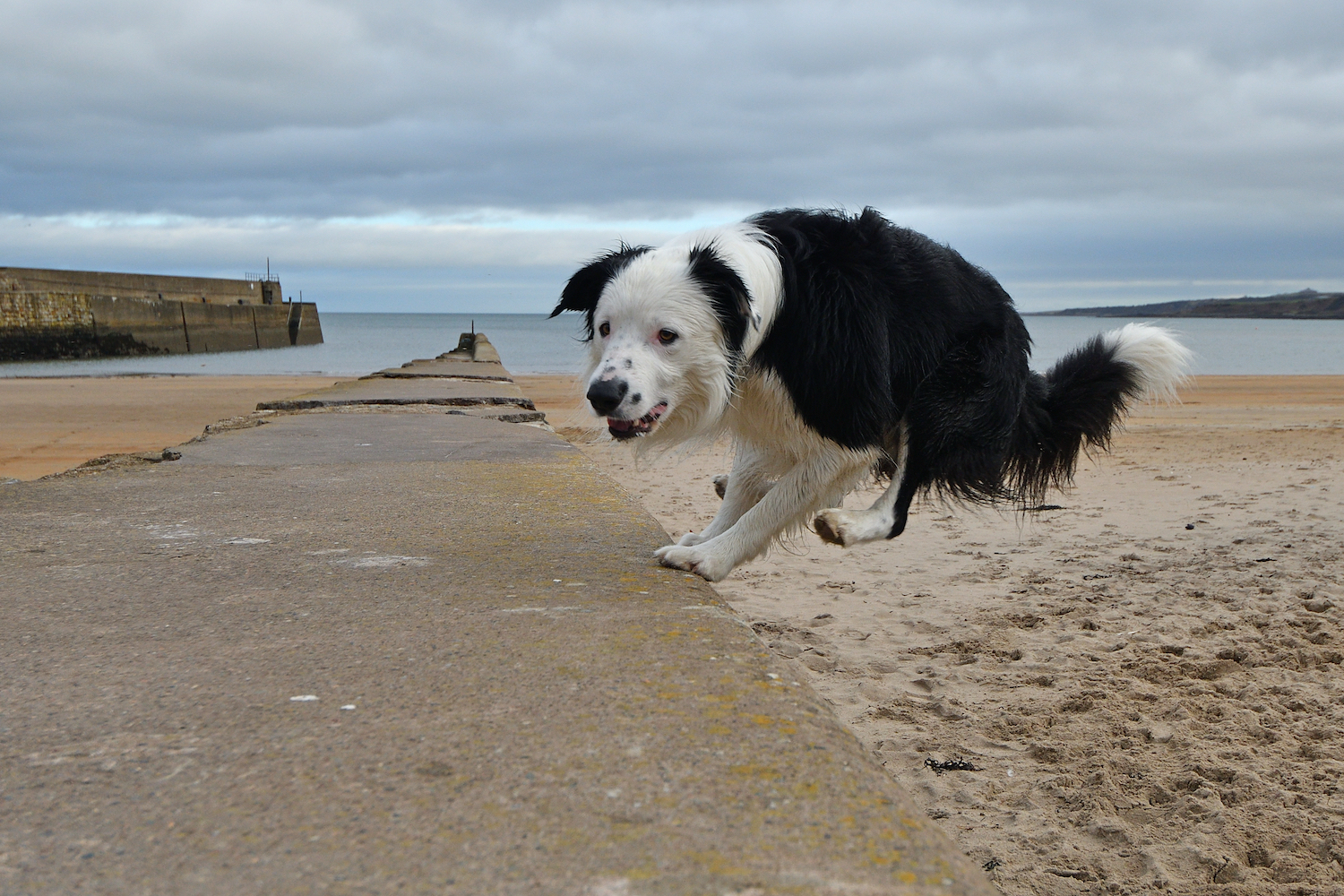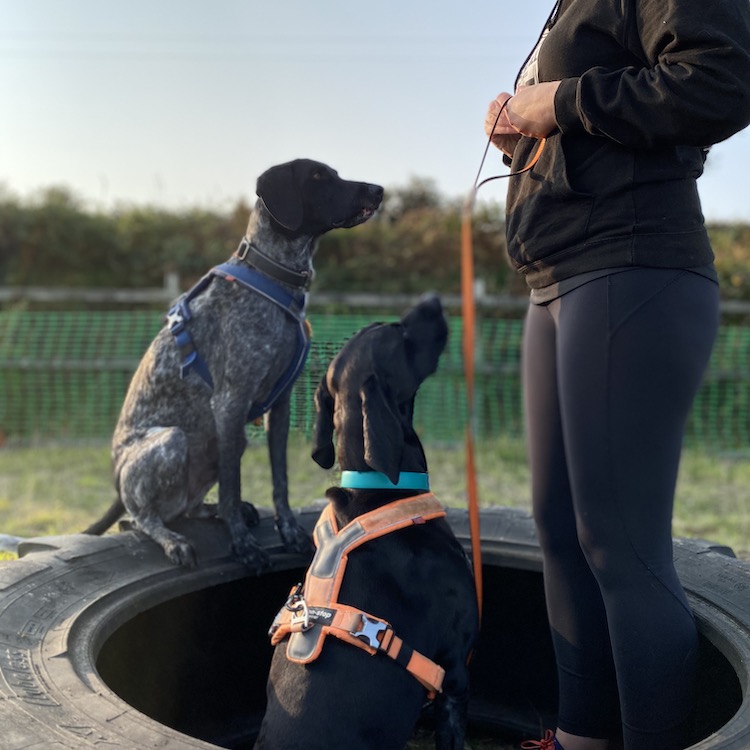
Dog Parkour is a new and fun sport that we can do with our dogs that encourages them to interact and engage with their environment, and although it might appear to be less extreme than its human counterpart it is still just as fun and challenging for your dog, Dog Parkour is often referred to as urban agility. The best thing about Dog Parkour is that it can be done anywhere, you don’t need fancy equipment or anything special to take part, you just use the environment around you and the obstacles that you find in it, a non-restrictive harness for your dog, a lead and your imagination.
We teach our dogs to engage with their environment in different ways, such as: getting them to stand with 2 or 4 feet on different objects or obstacles, crawling under obstacles, jumping over obstacles, walking and balancing on narrow beams or platforms, getting inside items, stretching against walls and walking on different surfaces – all of these challenge the dog’s fitness abilities and get their brain working as well.
Through Dog Parkour and playing games with our dogs, it turns our walks into an adventure and enables us to have fun with our dogs and strengthen our bond with them by encouraging our dogs to focus on us rather than sniffing out squirrels.
Benefits of Dog Parkour
Dog Parkour is also a brilliant way of increasing muscle mass and strength in our dogs and helping to strengthen the core muscles which can help towards preventing injury. By strengthening our dog’s muscles, and keeping them strong and fit, it can also be hugely beneficial to other sports that we might do with our dogs such as Canicross, Agility, Disc Dog or Fly ball. Parkour works loads of muscles in our dogs from their neck and back all the way down to their toes! Twenty minutes of Dog Parkour is the equivalent of an hours walk and can be more than enough to tire a dog out for a morning or afternoon.
Obstacles in Dog Parkour
The best part about Dog Parkour is that you don’t need any fancy or expensive equipment to get involved you can just use what you come across on your daily walks or have in your home already. Here are some of my favourite pieces of equipment or obstacles to use:
- Fallen trees or tree stumps that have been cut down and are flat
- Benches
- Boulders or big rocks
- Small/low walls
- Road cones for weaving
- Steps
- Tyres
- Boxes – cardboard or plastic
- Playgrounds/Parks (so long as they are empty and dogs are allowed)
- Trays, washing baskets, suitcases
- Low jumps – Homemade will do the job perfectly
“Dog Parkour is also a brilliant way of increasing muscle mass and strength in our dogs, and helping to strengthen the core muscles which can help towards preventing injury.”
Equipment for your dog
Ensure that your dog is wearing a well-fitting, non-restrictive harness (one that IS NOT Anti-pull as these work by restricting the dog’s movement).
You’ll also need a lead – one that is not too long as we don’t want it getting caught in any obstacles or get tangled up with the dog. You’ll need to ensure you are there to ‘spot’ your dog at all times, this means that you are there and able to prevent them falling or catch them or lessen the impact should they slip or fall from an obstacle. Safety is our priority in Parkour and we want your dog to enjoy themselves and have a great time.
Movements
Dog Parkour incorporates numerous movements and some of them are listed below. When it comes to Parkour the only limit is your own imagination:
- 4 Feet On Obstacle: All four feet of the dog must be on the obstacle.
- 2 Feet On Obstacle: Two feet must be on the obstacle – often the front two feet.
- Under: Dog crouches and moves under an obstacle.
- Through: Dog travels between 2 obstacles.
- In: Dog must place all 4 feet inside of an obstacle – such as a box, hoop or tray etc.
- Balance: Dog must safely balance and walk across an obstacle.
- Around: Move around an obstacle.
- Sequence of Multiple Movements: Complete 3 or more movements as part of a chain.

Safety
We must always put the safety of our dogs first and keep them safe and injury-free, we do this by ensuring that the obstacles are safe and secure and the surface is non-slip for our dogs. Dogs should be kept on the lead and we should be next to our dogs and able to ‘spot’ our dogs any time they are off the ground, this means if they were to fall we are able to lessen the fall and lessen the impact of the fall. It is not necessary to use obstacles that are high off the ground, using small obstacles is still very beneficial to our dogs.

How can dogs get involved in Dog Parkour?
The great thing about Dog Parkour is that any dog no matter their breed or age can take part, during Dog Parkour we encourage our dogs to move carefully and calmly so it is great for dogs that are growing older by helping to keep them active and keeping their muscles strong and healthy, it’s also brilliant for nervous dogs as it helps them gain confidence in their environment. I’d recommend going along to a class in Dog Parkour to start with, just so you know how to keep your dog safe whilst doing Parkour, there are various certified instructors all around the country and around the world should you wish to have a go.
Our Expert
One & All Dog Fitness has been created by a dog trainer with a love of fitness and a fitness instructor with a love of dogs. We run Canicross classes and 1:1’s in Cornwall and plan to add Dog Parkour and Dog Fitness classes to our class timetable later this year.
For more information: www.oneandalldogs.co.uk
